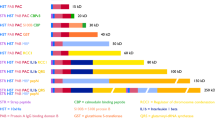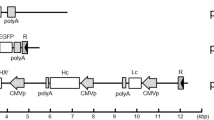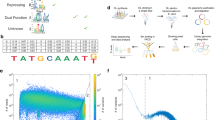Abstract
We have used mammalian cell lines, constructed with the expression system described, to express high levels of a heterologous gene product (human growth hormone) without recourse to gene amplification. The system employs commonly available components that combine efficiently to yield high expression. These components include the human metallothionein IIA promoter, Chinese hamster ovary cells and a protein free medium perfected for them. The system is suitable for large scale production during which growth hormone accumulates in the nutrient medium to levels above 200 mg/liter and purity of up to 90 percent.
This is a preview of subscription content, access via your institution
Access options
Subscribe to this journal
Receive 12 print issues and online access
$209.00 per year
only $17.42 per issue
Buy this article
- Purchase on Springer Link
- Instant access to full article PDF
Prices may be subject to local taxes which are calculated during checkout
Similar content being viewed by others
References
Kaufman, R.J., Wasley, L.C., Spiliotes, A.J., Gossels, S.D., Latt, S.A., Larsen, G.R. and Kay, R.M. 1985. Coamplification and coexpression of human tissue-type plasminogen activator and murine dihydrofolate reductase sequences in Chinese hamster ovary cells. Mol. Cell. Biol. 5:1750–1759.
McCormick, F., Trahey, M., Innis, M., Dieckmann, B. and Ringold, G. 1984. Inducible expression of amplified human beta interferon genes in CHO cells. Mol. Cell. Biol. 4:166–172.
Hamilton, W.G. and Ham, R.G. 1977. Clonal growth of Chinese hamster cell lines in protein-free media. 1977. In Vitro 13:537–547.
Haslinger, A. and Karin, M. 1985. Upstream promoter element of the human metallothionein-IIA gene can act like an enhancer element. 1985. Proc. Natl Acad. Sci. U.S.A. 82:8572–8576.
DeNoto, F.M., Moore, D.D. and Goodman, H.M. 1981. Human growth hormone DNA sequence and mRNA structure: possible alternative splicing. 1981. Nucleic Acids Res. 9:3719–3730.
Vieira, J. and Messing, J. 1982. The pUC plasmids, an M13mp7-derived system for insertion mutagenesis and sequencing with synthetic universal primers. 1982. Gene. 19:259–268.
Karin, M., Cathala, G. and Nguyen-Huu, M.C. 1983. Expression and regulation of a human metallothionein gene carried on an autonomously replicating shuttle vector. Proc. Natl. Acad. Sci. U.S.A. 80:4040–4044.
Karin, M. and Richards, R. 1982. Human metallothionein genes-primary structure of the metallothionein II gene and a related processed gene. 1982. Nature. 299:797–802.
Southern, P.J. and Berg, P. 1982. Transformation of mammalian cells to antibiotic resistance with a bacterial gene under control of the SV40 early region promoter. 1982. J. Mol. Appl. Gen. 1:327–341.
VanBrunt, J. Immobilized mammalian cells: The gentle way to productivity. 1986. Bio/Technology 4:508.
Static cell culture maintenance system. 1984. European patent application publication number 0 113 328 A2.
Feder, J. and Tolbert, W.R. 1983. The large scale cultivation of mammalian cells. Scientific American 248:36–43.
Tolbert, W.R., Lewis, C., White, P.J. and Feder, J. 1985. Perfusion culture systems for production of mammalian cell biomolecules, p. 97–123. In: Large-Scale Mammalian Cell Culture. W. R. Tolbert and J. Feder (Eds.) Academic Press, New York.
Bebbington, C.R. and Hentschel, C.C.G. 1987. The use of vectors based on gene amplification for the expression of cloned genes in mammalian cells, p. 163–188. In: DNA Cloning, Vol III, A Practical Approach. D. M. Glover (Ed.) IRL Press, Oxford, U.K.
Kaufman, R.J., Murtha, P., Ingolia, D.E., Yeung, C.-Y. and Kellems, R.E. 1986. Selection and amplification of heterologous genes encoding adenosine deaminase in mammalian cells. Proc. Natl. Acad. Sci. U.S.A. 80:3136–3140.
Rhodes, M. and Birch, J. 1988. Large-scale production of proteins from mammalian cells. Bio/Technology 6:518–523.
Handa-Corrigan, A. 1988. Large-scale in vitro hybridoma culture: current status. Bio/Technology 6:784–786.
Karin, M. and Holtgreve, H. 1984. Nucleotide sequence requirements for transient expression of human metallothionein-IIA-thymidine kmase fusion genes. DNA 3:319–325.
Author information
Authors and Affiliations
Rights and permissions
About this article
Cite this article
Friedman, J., Cofer, C., Anderson, C. et al. High Expression in Mammalian Cells Without Amplification. Nat Biotechnol 7, 359–362 (1989). https://doi.org/10.1038/nbt0489-359
Received:
Accepted:
Issue Date:
DOI: https://doi.org/10.1038/nbt0489-359



